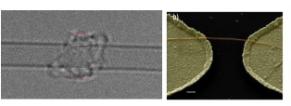
“There is plenty of room at the bottom” is specially enticing for spins There is a whole new world of phenomena that appears when spins are confined at the nanoscale or at low dimensions For example the spin in a single molecule can encode quantum information in Qbits or even perform logic operations as Qgates with unmatched reproducibility and scalability Besides, magnetic 2 D materials are particularly interesting testbeds to study a plethora of magnetic phenomena that may appear or be quenched at the 2 D limit, for example magnetic order, strong spin fluctuations, skyrmions and new quantum phases In spintronics those same magnetic materials and molecular spins could generate spin currents, spin filters, switches or spin valves among other applications T he combination of conductivity and magnetism in a robust 2 D heterostructure may be determinant to push forward a new generation of spintronics devices However the positioning of individual molecules or 2 D flakes into nanoscale devices, together with the typically insulating character of most molecule based and layered magnetic materials, challenges their implementation in nanoelectronics.
In this seminar I will show an introductory overview of the main ingredients that make magnetic molecules and 2 D materials good candidates for spintronics and quantum computation I will show how we overcome their limitations by creating mixed dimensional heterostructures that combine a magnetic part 0 D or 2 D) with other low dimensional materials that act as electrical and mechanical backbone to protect and sense the spin The heterostructures can be deterministically placed in nanoscale devices Some of the examples I will show are the encapsulation of spin crossover molecules within SWCNT and their placement between nanoscale electrodes Also, t he mechanical bond of magnetic porphyrin macrocycles, acting as Qubits, embracing SWCNTs Finally I will show different methods used to obtain thin layers of magnetic van der Waals crystals and the study of their magnetic properties down to the 2 D limit.
To join the group of "Department Seminars" click here.
Universidad Autónoma de Madrid © 2008 · Ciudad Universitaria de Cantoblanco · 28049 Madrid · Información y Conserjería: 91 497 43 31 E-mail: informacion.ciencias@uam.es Gestión de estudiantes de Grado y Posgrado: 91 497 8264 / 4329 / 4353 / 4349 / 6879 / 8362 E-mail: administracion.ciencias@uam.es